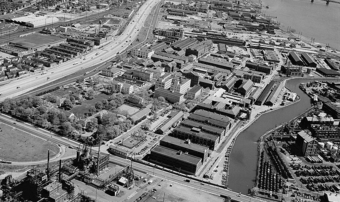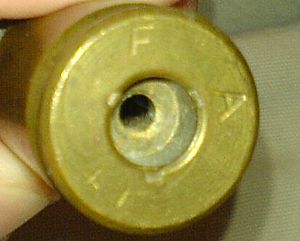Frankford Arsenal facts for kids
|
Frankford Arsenal
|
|

Aerial view to the northeast (1978)
|
|
| Location | Tacony and Bridge Sts. Philadelphia, Pennsylvania, United States |
|---|---|
| Area | 99.4 acres (40.2 ha) |
| Built | 1816 |
| NRHP reference No. | 72001153 100001935 (decrease) |
Quick facts for kids Significant dates |
|
| Added to NRHP | March 16, 1972 |
| Boundary decrease | December 28, 2017 |
The Frankford Arsenal was a very important factory for the United States Army. It was located in Philadelphia, Pennsylvania. This place used to make ammunition and other military supplies. It was a key center for designing and making ammunition for small guns until it closed in 1977.
Contents
History of the Frankford Arsenal
Early Years and the Civil War
The Frankford Arsenal opened in 1816. President James Madison bought 20 acres of land for it. It quickly became the main place for the U.S. military to design and develop ammunition for small guns.
During the American Civil War, the arsenal became very busy. Its commander, Josiah Gorgas, left to join the Confederate Army. By the end of the war, over 1,000 people worked there. The arsenal stored many weapons and artillery pieces. It also repaired military equipment for soldiers on horseback (cavalry) and foot soldiers (infantry). Workers cleaned small guns and made gunpowder. They also tested new types of gunpowder.
During the Battle of Gettysburg, the arsenal sent thousands of muskets and huge amounts of ammunition. These supplies went to Pennsylvania's "Emergency Militia" regiments. The arsenal also tested new inventions like the Gatling Gun. This was an early type of machine gun that was used a lot in the American Indian Wars.
World Wars and Growth
The arsenal was very active during World War I and World War II. It supplied many items for the war efforts. This created many jobs and brought money to the area. At its busiest, about 22,000 people worked there.
The Frankford Arsenal was like a small city on its own. It had its own police and fire departments. It also had dining halls, a motor pool for vehicles, and a full medical facility. It was part of a system of military bases across the country. Each base had specific jobs for the government.
Innovation and Research
From the start, the Frankford Arsenal designed and made military supplies. As weapons became more advanced, the arsenal's role grew. It started developing many advanced weapon systems for the Army.
The arsenal had famous labs like Pitman-Dunn Laboratories. Scientists and engineers there designed many things. They worked on everything from basic materials to LASER-guided missiles. They created these items from the first idea to the final product. They developed new computer programs for things like LASER rangefinders. They also made machines to help artillery calculate shots.
The labs had excellent workshops. They could do many tasks, from milling metal to making complex circuit boards. The Optical Lens Design Facility was one of the best in the country. They also fixed binoculars for soldiers. The Fire Control department even wrote the standards for glass and optics used across the United States.
After a new system was made, it was tested. This made sure it could handle tough conditions in the field. This testing happened at the arsenal's special environmental testing facility.
Closure of the Arsenal
As the U.S. military industry grew, the arsenal found it harder to compete. More and more of its projects were given to private companies. Eventually, the arsenal's jobs were moved to the Picatinny Arsenal in New Jersey. The engineers who worked on fire control and ammunition were transferred there until they retired.
During the 1976 presidential campaign, Walter Mondale was running for Vice President. He stood in front of the Frankford Arsenal and promised it would stay open. The Carter/Mondale team won the election. However, the promise was not kept. The arsenal closed for U.S. government use in 1977.
Before it closed, many special designs were created and tested. This included using aluminum and steel to make cartridge cases.
The northern part of the site is now used by the Pennsylvania Fish and Boat Commission. It is a place for boats and fishing on the Delaware River. In August 2018, six buildings on the southern part of the property were bought by a company. They plan to use them for light industry and offices.
Munition Markings
Every round of ammunition made at Frankford Arsenal had a special mark. It was called a headstamp and said "F A" on its base. This showed it was made there.
Very early metal cartridges from Frankford did not have headstamps. These were made of copper. Some early cartridges were stamped "F" for Frankford. Others had "R" for rifle or "C" for carbine. Before World War I, ammunition was marked with the month and year it was made. For example, "8 79" meant August 1879.
Special 7.62 mm (.308) cartridge cases were made in small amounts. Cartridges that met NATO standards had a NATO cross mark. This was a circle with a "+" inside it.



